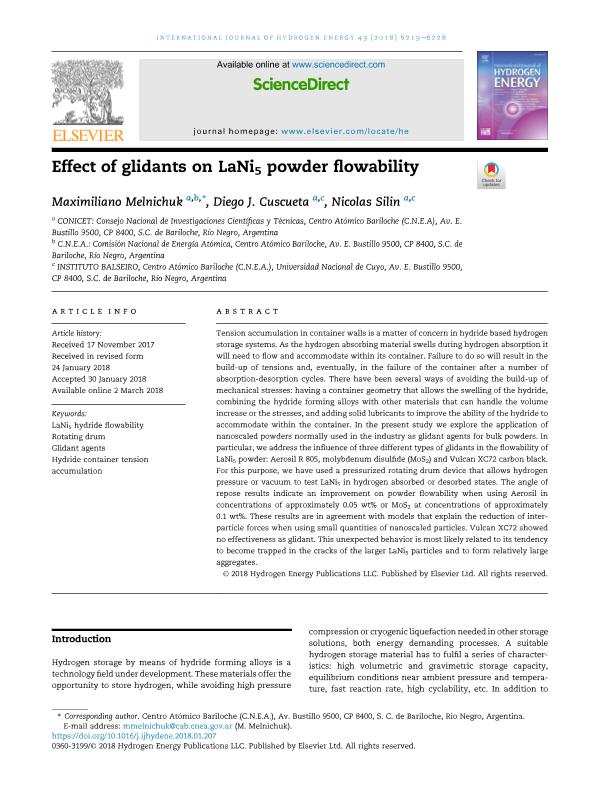Mostrar el registro sencillo del ítem
dc.contributor.author
Melnichuk, Maximiliano

dc.contributor.author
Cuscueta, Diego Javier

dc.contributor.author
Silin, Nicolas

dc.date.available
2020-03-13T19:57:38Z
dc.date.issued
2018-03
dc.identifier.citation
Melnichuk, Maximiliano; Cuscueta, Diego Javier; Silin, Nicolas; Effect of glidants on LaNi5 powder flowability; Pergamon-Elsevier Science Ltd; International Journal of Hydrogen Energy; 43; 12; 3-2018; 6219-6228
dc.identifier.issn
0360-3199
dc.identifier.uri
http://hdl.handle.net/11336/99582
dc.description.abstract
Tension accumulation in container walls is a matter of concern in hydride based hydrogen storage systems. As the hydrogen absorbing material swells during hydrogen absorption it will need to flow and accommodate within its container. Failure to do so will result in the build-up of tensions and, eventually, in the failure of the container after a number of absorption-desorption cycles. There have been several ways of avoiding the build-up of mechanical stresses: having a container geometry that allows the swelling of the hydride, combining the hydride forming alloys with other materials that can handle the volume increase or the stresses, and adding solid lubricants to improve the ability of the hydride to accommodate within the container. In the present study we explore the application of nanoscaled powders normally used in the industry as glidant agents for bulk powders. In particular, we address the influence of three different types of glidants in the flowability of LaNi5 powder: Aerosil R 805, molybdenum disulfide (MoS2) and Vulcan XC72 carbon black. For this purpose, we have used a pressurized rotating drum device that allows hydrogen pressure or vacuum to test LaNi5 in hydrogen absorbed or desorbed states. The angle of repose results indicate an improvement on powder flowability when using Aerosil in concentrations of approximately 0.05 wt% or MoS2 at concentrations of approximately 0.1 wt%. These results are in agreement with models that explain the reduction of interparticle forces when using small quantities of nanoscaled particles. Vulcan XC72 showed no effectiveness as glidant. This unexpected behavior is most likely related to its tendency to become trapped in the cracks of the larger LaNi5 particles and to form relatively large aggregates.
dc.format
application/pdf
dc.language.iso
eng
dc.publisher
Pergamon-Elsevier Science Ltd

dc.rights
info:eu-repo/semantics/openAccess
dc.rights.uri
https://creativecommons.org/licenses/by-nc-sa/2.5/ar/
dc.subject
GLIDANT AGENTS
dc.subject
HYDRIDE CONTAINER TENSION ACCUMULATION
dc.subject
LANI5 HYDRIDE FLOWABILITY
dc.subject
ROTATING DRUM
dc.subject.classification
Ingeniería de los Materiales

dc.subject.classification
Ingeniería de los Materiales

dc.subject.classification
INGENIERÍAS Y TECNOLOGÍAS

dc.title
Effect of glidants on LaNi5 powder flowability
dc.type
info:eu-repo/semantics/article
dc.type
info:ar-repo/semantics/artículo
dc.type
info:eu-repo/semantics/publishedVersion
dc.date.updated
2019-10-15T17:29:09Z
dc.journal.volume
43
dc.journal.number
12
dc.journal.pagination
6219-6228
dc.journal.pais
Estados Unidos

dc.description.fil
Fil: Melnichuk, Maximiliano. Comisión Nacional de Energía Atómica. Centro Atómico Bariloche; Argentina. Consejo Nacional de Investigaciones Científicas y Técnicas. Centro Científico Tecnológico Conicet - Patagonia Norte; Argentina
dc.description.fil
Fil: Cuscueta, Diego Javier. Comisión Nacional de Energía Atómica. Gerencia del Área de Energía Nuclear. Instituto Balseiro; Argentina. Consejo Nacional de Investigaciones Científicas y Técnicas. Centro Científico Tecnológico Conicet - Patagonia Norte; Argentina. Comisión Nacional de Energía Atómica. Centro Atómico Bariloche; Argentina
dc.description.fil
Fil: Silin, Nicolas. Consejo Nacional de Investigaciones Científicas y Técnicas. Centro Científico Tecnológico Conicet - Patagonia Norte; Argentina. Comisión Nacional de Energía Atómica. Gerencia del Área de Energía Nuclear. Instituto Balseiro; Argentina. Comisión Nacional de Energía Atómica. Centro Atómico Bariloche; Argentina
dc.journal.title
International Journal of Hydrogen Energy

dc.relation.alternativeid
info:eu-repo/semantics/altIdentifier/url/https://www.sciencedirect.com/science/article/pii/S0360319918303628
dc.relation.alternativeid
info:eu-repo/semantics/altIdentifier/doi/http://dx.doi.org/10.1016/j.ijhydene.2018.01.207
Archivos asociados
